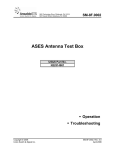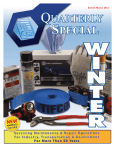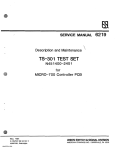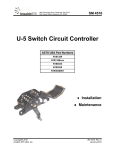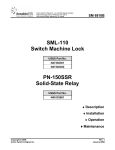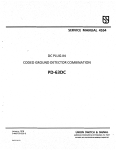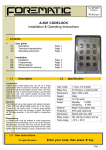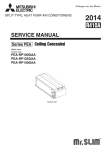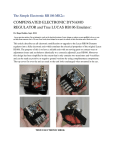Download ATT-20 Audio Track Transceiver
Transcript
SM 6299 1000 Technology Drive, Pittsburgh, PA 15219 645 Russell Street, Batesburg, SC 29006 ATT-20 Audio Track Transceiver US&S Part No. N454052-3901 through N454052-3906 Installation Operation Troubleshooting Copyright © 2008 Union Switch & Signal Inc. SM 6299, Rev. 1.0 June 2008 Notices Proprietary Notice This document and its contents are the property of Union Switch & Signal Inc. (hereinafter US&S). This document has been furnished to you on the following conditions: no right or license under any patents or any other proprietary right in respect of this document or its content is given or waived in supplying this document. This document or its content are not to be used or treated in any manner inconsistent with the rights of US&S, or to its detriment, and are not to be copied, reproduced, disclosed to others, or disposed of except with the prior written consent of US&S. Important Notice US&S constantly strives to improve our products and keep our customers apprised of changes in technology. Following the recommendations contained in the attached service manual will provide our customers with optimum operational reliability. The data contained herein purports solely to describe the product, and does not create any warranties. Within the scope of the attached manual, it is impossible to take into account every eventuality that may arise with technical equipment in service. Please consult your local US&S sales representative in the event of any irregularities with our product. We expressly disclaim liability resulting from any improper handling or use of our equipment, even if these instructions contain no specific indication in this respect. We strongly recommend that only approved US&S spare parts are used as replacements. SM 6299, Rev. 1.0, June 2008 i Revision History Revision History REV. ii DATE 0 April 1997 1.0 June 2008 NATURE OF REVISION Initial issue Revised to current template. Updated parts lists and drawings. Incorporated ECO EE-1223 (2/00). Miscellaneous minor grammatical changes. Proof read comments resolved. SM 6299, Rev. 1.0, June 2008 Table of Contents Table of Contents 1. GENERAL INFORMATION ...............................................................................................................1-1 1.1. Introduction ............................................................................................................................... 1-1 1.2. Physical Description ................................................................................................................. 1-1 1.3. Specifications............................................................................................................................ 1-1 1.3.1. Power Requirements ....................................................................................................1-1 1.3.2. Transceiver Characteristics ..........................................................................................1-2 1.3.3. Receiver Characteristics...............................................................................................1-2 1.3.4. Miscellaneous ...............................................................................................................1-3 2. APPLICATION, INSTALLATION, AND ADJUSTMENTS ................................................................2-1 2.1. General ..................................................................................................................................... 2-1 2.2. Shunt Mode Track Circuit Application ...................................................................................... 2-1 2.3. Series Mode Track Circuit Application...................................................................................... 2-2 2.4. Terminal Connections............................................................................................................... 2-3 2.5. Mounting Requirements............................................................................................................ 2-3 2.6. General Considerations ............................................................................................................ 2-3 2.7. Shunt Mode Operation.............................................................................................................. 2-4 2.7.1. Shunt Mode Installation ................................................................................................2-4 2.7.2. Shunt Mode Adjustment ...............................................................................................2-5 2.8. Series Mode Operation............................................................................................................. 2-6 2.8.1. Series Mode Installation ...............................................................................................2-6 2.8.2. Series Mode Adjustment without Cable Compensating PCB.......................................2-6 2.8.3. Series Mode Adjustment with Cable Compensating PCB............................................2-7 2.9. Lightning Protection .................................................................................................................. 2-7 3. FUNCTIONAL DESCRIPTION ..........................................................................................................3-1 3.1. General ..................................................................................................................................... 3-1 3.2. Shunt Mode Track Circuit ......................................................................................................... 3-1 3.3. Series Mode Track Circuit ........................................................................................................ 3-1 3.4. Detailed Circuit Description ...................................................................................................... 3-1 3.4.1. Transmitter....................................................................................................................3-1 3.4.2. Receiver........................................................................................................................3-2 4. FIELD MAINTENANCE .....................................................................................................................4-1 4.1. General ..................................................................................................................................... 4-1 4.2. Test Equipment......................................................................................................................... 4-1 4.3. General Checks ........................................................................................................................ 4-1 4.4. Shunt Mode Checks ................................................................................................................. 4-1 4.5. Series Mode Checks................................................................................................................. 4-3 5. SHOP MAINTENANCE .....................................................................................................................5-1 SM 6299, Rev. 1.0, June 2008 iii Table of Contents 6. PARTS LISTS....................................................................................................................................6-1 6.1. ATT-20 Audio Track Receiver Kits ........................................................................................... 6-1 6.2. ATT-20 Audio Track Transceiver Units .................................................................................... 6-1 6.3. ATT-20 Audio Track Receiver Parts List .................................................................................. 6-2 6.4. Cable Compensating PCB Parts List........................................................................................ 6-5 7. RAIL TEAM AND TECHNICAL SUPPORT ......................................................................................7-1 List of Figures Figure 1-1. ATT-20 Dimensions ......................................................................................................... 1-3 Figure 2-1. Shunt Mode Track Circuit Application.............................................................................. 2-1 Figure 2-2. Series Mode Track Circuit Application ............................................................................. 2-2 Figure 2-3. Lightning Arrester and Surge Ripple Filter for Shunt Mode Application .......................... 2-8 Figure 2-4. Lightning Arrester and Surge Ripple Filter for Series Mode Application ......................... 2-9 Figure 3-1. Transmitt6er PCB Schematic Diagram ............................................................................ 3-3 Figure 3-2. Receiver PCB Schematic Diagram .................................................................................. 3-4 Figure 4-1. ATT-20 Test Circuit for Shunt Mode Application ............................................................. 4-2 Figure 4-2. ATT-20 Test Circuit for Series Mode Application............................................................. 4-3 Figure 6-1. ATT-20 Wiring Diagram ................................................................................................... 6-3 Figure 6-2. ATT-20 Parts Illustration .................................................................................................. 6-4 Figure 6-3. Cable Compensating PCB Parts Layout and Schematic Diagram .................................. 6-5 List of Tables Table 1-1. Adjacent Frequency Rejection ......................................................................................... 1-2 Table 2-1. Terminal Assignments...................................................................................................... 2-3 Table 2-2. Ring-by Parameters for 0.1 Ohm Shunting...................................................................... 2-5 Table 2-3. Cable Length vs. Frequency ............................................................................................ 2-6 Table 6-1. ATT-20 Unit Kits...............................................................................................................6-1 Table 6-2. ATT-20 Unit (Only) ........................................................................................................... 6-1 Table 6-3. Miscellaneous Application Units ...................................................................................... 6-1 Table 6-4. ATT-20 Unit Parts List...................................................................................................... 6-2 Table 6-5. ATT-20 Part Tabulation.................................................................................................... 6-3 Table 6-6. Cable Compensating PCB Parts List ............................................................................... 6-5 iv SM 6299, Rev. 1.0, June 2008 General Information 1. GENERAL INFORMATION 1.1. Introduction This manual provides application, installation and maintenance information for the Union Switch & Signal Audio Track Transceiver, Model ATT-20. The ATT-20 is a short-range transceiver operating in the audio frequency range of 12 to 20 KHz. The high frequency range was chosen to provide sharp block definition. The ATT-20 can be used in applications such as highway crossings, island circuits, switch lock release and general train detection in non-electrified and DC electrified territories. In most cases, insulated joints are not required and track circuits up to 300 feet in length can be realized. Units are available for operation in either shunt mode or series mode applications. 1.2. Physical Description The ATT-20 is a single unit transceiver containing separate transmitter and receiver printed circuit boards, mounted on a common chassis. The chassis is housed in a sheet metal box. The top cover of the unit is the faceplate to which AAR terminal posts are mounted. 1.3. Specifications 1.3.1. Power Requirements Power Supply Voltage: 9.8 - 15.2 Vdc Maximum Ripple: 1 Vpp Load Current: 600 mA. Fuse: 3 / 4 Amp fast blow SM 6299, Rev. 1.0, June 2008 1-1 General Information 1.3.2. Transceiver Characteristics CAUTION The ATT 20 may be operated from a constant potential rectifier (CPR) supply, batteries floating on a CPR, or an electronically regulated supply. Regardless of the supply used, a surge ripple filter (US&S N451590-0301) must be used between the supply and the ATT-20 Transceiver. Shunt Mode Output Voltage: Series Mode Output Voltage: Available Operating Frequencies: Carrier Frequency Tolerance: Modulation Frequency (All Units): Harmonic Output: 1.0 Vrms (modulated) into a 5-ohm load 0.25 Vrms (modulated) into a 1-ohm load 12.28 KHz, 15.0 KHz, 20 KHz. + 0.5 % 390 Hz + 0.5% -30 dB at second harmonic with 12 ohm load in shunt mode 7 ohm shunt mode; 1 ohm series mode 1.3.3. Receiver Characteristics Sensitivity: Input Impedance: Output Voltage: 70 mVrms (modulated signal) + 14 mV 7 ohms shunt mode, 1 ohm series mode 7.65 Vdc into 400 ohms Table 1-1. ATT-20 Frequency (KHZ) 12.28 15.0 20.0 Adjacent Frequency Rejection Adjacent Frequency of Concern (KHz) Rejection of Adjacent Frequency (dB) 15.0 -18.0 12.28 -30.0 18.0* -21.0 20.0 -27.0 15.0 -44.0 18.0* -23.0 * Of concern where joint detectors are used. 1-2 SM 6299, Rev. 1.0, June 2008 General Information 1.3.4. Miscellaneous Reverse battery protection: Operating temperature range: Maximum block length: Built-in - 40°C to +70°C 300 ft. shunt mode at 3 ohm/1000 ft. ballast; 150 ft. series mode at 3 ohms/1000 ft. ballast. PN-150B, 400 ohm coil, (US&S N322500-701) Refer to Figure 1-1. Recommended Relay: Overall Dimensions: Mounting Hole Dimensions: Weight: Terminal Connections: 2¼" x 8½" 4 lbs., 14 oz. AAR 4 5/8 (REF) 2 1/8 (REF) 2 1/4 (REF) 1 5 3 6 1/16 (REF) 7 4 6 XMT RCV 8 + RELAY - 91 /4 (REF) 2 + BATTERY - 8 (REF) 7 5/8 (REF) TL6 TL5 LOWER RAISE RELAY VOLTS SHUNT MODE UNIT AUDIO TRACK TRANSCEIVER MODEL,ATT-20 PC.NO. SER.NO. FREQ. REV. TL1 TL2 3B3.0001.00 TL4 TL3 Figure 1-1. ATT-20 Dimensions SM 6299, Rev. 1.0, June 2008 1-3 General Information 1-4 SM 6299, Rev. 1.0, June 2008 Application, Installation, and Adjustments 2. APPLICATION, INSTALLATION, AND ADJUSTMENTS 2.1. General This section provides information on the application of the ATT-20, as well as installation and adjustment procedures for the ATT-20 and related equipment. It is also critical that this section be read in its entirety prior to any application considerations. 2.2. Shunt Mode Track Circuit Application In this application, the transmitter output and receiver input are connected by cable directly to the rails. The connection is made through surge protectors by twisted line pairs as shown in Figure 2-1. The point at which the transmitter wires are connected defines one end of the track circuit. While the other end of the track circuit is defined by the receiver connections to the track. The receiver detects the presence of a train by the loss of the audio frequency signal that is shunted away by the train axle. The shunt mode of operation is defined as a vital application. 300 FEET RING-BY MAX. USSP-21 USSP-21 1 3 1 3 2 4 2 4 1 3 5 7 2 4 6 8 HARDWARE SHUNT USED DURING SET-UP TO BATTERY ATT-20 3B3.0002.00 TWISTED PAIR Figure 2-1. Shunt Mode Track Circuit Application SM 6299, Rev. 1.0, June 2008 2-1 Application, Installation, and Adjustments 2.3. Series Mode Track Circuit Application In this application, the transmitter and receiver are wired in sequence via a jumper on the ATT20 unit. This jumper connects transmitter output terminal 4 to the receiver input terminal 6. The remaining transmitter output lead (terminal 3) and the remaining receiver lead (terminal 5) are twisted as a pair and each is connected to its respective rail (see Figure 2-2). The presence of a train axle across the rails completes the series signal path, thus detecting the approach of a train. The series mode of operation is a non-vital application. 75 FEET 60 FEET “O” OHM SHUNT 1 3 1 3 12V BATTERY 2 2 USSP-21 4 4 5 7 6 8 ADJUSTMENT SHUNT _ ATT-20 + CABLE COMPENSATING PCB L1 3B3.0003.00 1 C1 2 TWISTED PAIR T2 T3 T1 CT Figure 2-2. Series Mode Track Circuit Application 2-2 SM 6299, Rev. 1.0, June 2008 Application, Installation, and Adjustments 2.4. Terminal Connections AAR type terminals are located on the top of the unit for making external connections. Refer to Table 2-1. Table 2-1. Terminal Assignments Terminal No. Description 1 + Battery 2 - Battery 3 Transmitter Lead 4 Transmitter Lead 5 Receiver Lead 6 Receiver Lead 7 + Relay 8 - Relay Internal wiring is accessed through a grometted hole in the faceplate. Also located on the faceplate is an access hole which is intended for setting transmitter gain. This is a simple adjustment and can be accomplished with a screwdriver. 2.5. Mounting Requirements A convenient mounting bracket, which is an integral part of the case, provides four holes spaced 2-1/4 x 8-1/2 apart to facilitate wall, shelf or rack mounting. 2.6. General Considerations a. Track leads to the transmitter and receiver must be a #9 AWG or heavier twisted pair. b. Power supply must be 9.8 - 15.2 Vdc and capable of supplying 1 ampere. A surge ripple filter (US&S Part No. N451590-0301) must be used between any supply and the ATT-20. Power supply ripples must not exceed 1.0 Vpp. c. Use higher frequency units when less ring-by is desired. d. Provide lightning protection per Section 2.9. e. The relay recommended to be used with ATT-20 is a vital PN-150B, US&S No. N322500701, 400 ohm, plug-in type. SM 6299, Rev. 1.0, June 2008 2-3 Application, Installation, and Adjustments 2.7. Shunt Mode Operation CAUTION When using the shunt track circuit configuration, do not repeat the use of the same frequency unless circuits are isolated by at least two (2) insulated points. Where less ring-by is desired, keep the track circuit length to a minimum and use the shortest possible track leads. Refer to Figure 2-1 and Table 2-2 for shunt track circuit application. 2.7.1. Shunt Mode Installation a. Connect transmitter terminals 3 and 4 to terminals 3 and 4 of the USS-21 surge suppressor. Continue the cabling to the track from terminals 1 and 2 of the USSP-21. Repeat the above procedure for cabling receiver input terminals 5 and 6 to the rails. All transmitter and receiver cables must be #9 AWG or heavier and used as a twisted pair. Ensure the combined lengths of the transmitter and receiver cables do not exceed 500 ft. Also, do not exceed block lengths of 300 ft. b. Connect terminals 7 (relay +) and 8 (relay -) to the relay. The recommended relay to be used with the ATT-20 is a PN-150B, 400 ohm plug-in type, US&S Part No.: N322500-701. c. If the ATT-20 is to receive its DC power from a battery or constant potential rectifier supply (CPR) or an electronically regulated supply, a surge ripple filter (Part No. N451590-0301) must be used as follows (on the next page): d. Connect terminals 1 (+) and 2 (-) of the ATT-20 to respective "+DC" and "-DC" terminals of the ripple filter. Jumper terminals 2 to N on the ripple filter and cable terminals B (positive) and N (negative) to their respective battery bus or supply terminals. Lightning arrestor USGA N451552-0101 should be across ripple filter terminals B and N. Refer to Section 2.9 for the details on lightning protection. e. If the ATT-20 is to be powered from an electronic supply, this supply should be capable of delivering 1.0 ampere at 12 Vdc (on the ATT-20 side of the surge ripple filter) and be dedicated to the ATT-20 it is powering. 2-4 SM 6299, Rev. 1.0, June 2008 Application, Installation, and Adjustments 2.7.2. Shunt Mode Adjustment a. Connect a hardwire shunt across the rails outside the defined block at the desired ring-by distance from the ATT-20 receiver track connections (terminals 5 and 6). Table 2-2 shows typical ring-by parameters for 3.0 ohm/1000’ ballast and 0.1 ohm adjustment shunt. Note The adjustment shunt mentioned below is not a hard-wire shunt. This shunt must accurately represent the desired shunting sensitivity. b. b. Adjust the ATT-20 transmitter output level through the access hole in the top cover until the relay is energized. c. Remove the hardwire shunt from the rails. d. Place an adjustment shunt across the rails at the receiver connection (not the ring-by distance). The relay should drop out. A compromise between the shunting sensitivity (adjustment shunt) and ring-by distance will be achieved per application. e. Remove the adjustment shunt from the rails. The adjustment procedure is complete. Table 2-2. Ring-by Parameters for 0.1 Ohm Shunting Track Length (Ft.) Total Cable Length (Ft.) 100 100 300 500 200 300 500 300 400 500 200 300 SM 6299, Rev. 1.0, June 2008 Typical Minimum Ring-By (Ft.) 12.28 KHZ 11 14 19 18 21 29 30 35 40 15.0 KHz 10 14 19 18 21 29 30 36 43 20.0 KHz 9 13 19 17 22 33 33 41 52 2-5 Application, Installation, and Adjustments 2.8. Series Mode Operation Series track circuit locations operating at the same frequency must be separated by at least two insulated joints. A typical series mode application would be at a switch lock. Refer to Figure 2-2 for this application. 2.8.1. Series Mode Installation a. Connect a jumper strap between terminals 4 and 6 on the ATT-20 when the total single conductor cable length from the ATT-20 to the track is less what appears in Table 2-3 below. If the cable length is exceeded, connect terminals 4 and 6 on the ATT-20 to terminals 1 and 2, respectively, on the cable compensating circuit board (N131002-01) Table 2-3. Suffix No. N451052- Frequency (KHz) -3904 -3905 -3906 12.28 15 20 Cable Length vs. Frequency Total Cable Length (Length x 2 cond.) < 75 feet < 50 feet < 25 feet Jumper from Cable Compensating PCB to Terminal: T3 T2 T1 b. Connect terminals 3 and 5 to terminals 3 and 4 of the USSP-21 surge suppressor. Connect terminals 1 and 2 of the USSP-21 to the track at a point 75 feet from the switch points. All cabling from the ATT-20 to the track must be #9 AWG or heavier twisted pair. c. Connect terminals 7 (relay +) and 8 (relay -) to the relay. The recommended relay to be used with the ATT-20 is a PN-150B, 400 ohm, plug-in type, Part No. N322500-701. d. If the ATT-20 is to receive its DC power from a battery, constant potential rectifier supply (CPR), or an electronically regulated supply, a surge ripple filter (Part No. N451590-0301) must be used as follows: If the ATT-20 is to be powered from an electronic supply, this supply should be capable of delivering 1.0 ampere at 12 Vdc (on the ATT-20 side of the surge ripple filter) and be dedicated to the ATT-20 it is powering. 2.8.2. Series Mode Adjustment without Cable Compensating PCB a. Connect a hardwire shunt across the rails 65 feet from the ATT-20 track connections. b. Adjust the ATT-20 transmitter output level through the access hole in the top cover until the relay is just energized. c. Remove the hardwire shunt from the rails. The adjustment procedure is complete. 2-6 SM 6299, Rev. 1.0, June 2008 Application, Installation, and Adjustments 2.8.3. Series Mode Adjustment with Cable Compensating PCB a. Place an “O” ohm shunt across the track connections at the feed end. b. Connect an AC voltmeter (Vrms) across terminals 5 and 6 on the ATT-20. c. On the cable compensating PC board, adjust the slug in pot core inductor “L1” until the voltmeter indicates a maximum. Note Depending on cable length, peaking of the signal might not be possible. After adjustment of inductor, place a small amount of RTV in the pot core adjuster area. d. Remove the “O” ohm shunt. e. Adjust track circuit as shown above in section 2.8.2. 2.9. Lightning Protection Two lightning protection devices are to be used with the ATT-20. The track connections will be made through a USSP-21 secondary surge protection and the battery power supply line will be protected by a surge ripple filter which uses a USG-A lightning arrester across the power bus terminals. The USSP-21 surge protector is wired to permit line-to-line protection using a low voltage arrester and line-to-ground protection using high voltage arresters. Internal circuitry of the USSP-21 also includes series line inductors as well as back-to-back Zener diodes for suppression of low voltage transients. The US&S part no. is N451552-0525. The surge ripple filter consists of a series line inductor and a four-terminal capacitor with a selenium suppressor diode across its terminals. The four-terminal capacitor guarantees loss of power to the load should one of the capacitor leads or plates open. The line-to-line arresters used across terminals 1 and 2 of the USSP-21 and terminals B and N of the Surge Ripple Filter are USG-A N451552-0101. The line-to-ground arresters used across terminals 1 and 5, 2 and 6 of the USSP-21are USG-A N451552-0201. Block wiring diagrams showing the wiring of surge and ripple protection for the ATT-20 in both the shunt and series modes of operation appear in Figure 2-3 and Figure 2-4, respectively. SM 6299, Rev. 1.0, June 2008 2-7 Application, Installation, and Adjustments TO TRACK TO TRACK 1 USSP-21 5 2 1 6 5 2 USSP-21 3 4 3 3 4 5 TRANSMITTER 6 4 6 RECEIVER ATT-20 1 + DC + DC SURGE RIPPLE FILTER (N451590-0301) 7 2 + DC 8 RELAY _ _ DC 4 2 8 3B3.0004.00 _ N TO BATTERY OR POWER SUPPLY LIGHTNING ARRESTER PART NO. N451552-0101 TWISTED PAIR Figure 2-3. Lightning Arrester and Surge Ripple Filter for Shunt Mode Application 2-8 SM 6299, Rev. 1.0, June 2008 Application, Installation, and Adjustments TO TRACK 1 5 2 USSP-21 3 3 8 4 6 4 5 RECEIVER TRANSMITTER ATT-20 1 + 2 DC _ + DC DC 3B3.0005.00 4 8 7 DC + RELAY _ _ 2 TO BATTERY OR POWER SUPPLY TWISTED PAIR LIGHTNING ARRESTER PART NO. N451552-0101 Figure 2-4. Lightning Arrester and Surge Ripple Filter for Series Mode Application SM 6299, Rev. 1.0, June 2008 2-9 Application, Installation, and Adjustments 2-10 SM 6299, Rev. 1.0, June 2008 Functional Description 3. FUNCTIONAL DESCRIPTION 3.1. General The transmitter produces an output signal in the high audio frequency range and is sine wave modulated to provide noise immunity. First, the receiver detects the modulation information signal. It then amplifies and rectifies this signal to provide a DC output which drives the relay coil. Functional description of the ATT-20 applied to the shunt track circuit is covered in Section 3.2. Section 3.3 covers the series mode track circuit. 3.2. Shunt Mode Track Circuit As illustrated in Figure 2-1, the transmitter output and receiver input are cabled directly to the rails. The point at which the transmitter wires are connected defines one end of the track circuit. The other end of the track circuit is defined by the receiver connections to the track. The receiver detects the presence of a train by the loss of the audio frequency signal which is shunted away by the train axle. The shunt mode of operation is defined as a vital application. 3.3. Series Mode Track Circuit As illustrated in Figure 2-2, the transmitter and receiver are wired in series via a jumper located on the ATT-20 unit. This jumper connects the transmitter output terminal to the receiver input terminal. The remaining transmitter output lead and the remaining receiver lead are twisted as a pair with each is connected to its respective rail. The presence of a train axle across the rails completes the series signal path, thus detecting the presence of a train The series mode of operation is a non-vital application. 3.4. Detailed Circuit Description 3.4.1. Transmitter The transmitter circuit diagram is shown in Figure 3-1. Transistor Q1 and its associated circuitry comprise the modulation oscillator which produces 390 Hz. A constant signal level is maintained by Zener diode D1. Transistor Q2 buffers the modulation oscillator. Transistor Q7 and its associated circuitry comprise the carrier frequency oscillator. Selection of capacitor C3 determines the carrier frequency. Transistors Q3, R8 and R13 mix the carrier and modulation signals. Resistor R14 provides gain control. Inductor L1, capacitor C5, and resistor R17 form a bandpass filter which allows the modulated carrier to pass unaltered by low frequency or higher order harmonic disturbances. SM 6299, Rev. 1.0, June 2008 3-1 Functional Description Resistor R15 and R19 form a voltage divider which sets the bias for transistor Q4. Capacitor C12 bypasses resistor R19. Transistors Q4, Q5, Q6 and Q8 make up a unity gain amplifier with low output impedance. Diodes D4, D5, D6 and D8 - along with resistors R20 and R21 - serve to temperature compensate and bias both transistors Q5 and Q6. C13 is a bypass capacitor. Capacitor C6 and the primary of T3 couple the signal to the output circuitry. Inductor L5, jumper J2 and capacitor C9 from the shunt mode output, providing an output impedance of 7 ohms. Inductor L6, jumper J1 and capacitor C9 form the series mode output with an output impedance of 1 ohm. Diode D7 prevents damage from reverse battery connection. Fuse F1 prevents damage from an overcurrent condition. Inductors L2, L3 and capacitor C11 provide RFI rejection. Capacitors C7 and C10 filter the power bus. 3.4.2. Receiver The receiver circuit diagram is shown in Figure 3-2. Capacitor C1, transformer T1 and resistor R1 form a medium Q input filter. Jumper positions should be J1 and J3 for both shunt and series mode boards. The input impedance is primarily determined by R1 (Shunt boards = 7 ohms, series boards = 1 ohm). Transistors Q1 and Q2 form a Darlington pair emitter follower which buffers the input signal. Resistor R4 and Zener diode D10 provide a fixed bias voltage for Q1 and Q2. Inductors L3 and L4; capacitor C3, C4 and C5; and resistors R6 and R7, together form a high Q bandpass filter. Diode D1 demonstrates the signal. Resistor R8 and capacitor C6 filter the carrier frequency. Transistor Q3 and its associated circuitry form an emitter follower to buffer the demodulated signal. Resistor R13 is selected to provide an input sensitivity of 70 mVrms (modulated signal). Transformer T2 and capacitor C9 form the demodulated filter. Transistors Q4 and Q5 are configured as an emitter follower which buffers the demodulated signal. Capacitors C11 and C12, along with diode D3 and D4, form a voltage doubler. This doubler produces a negative DC voltage which drives a level detector. The level detector consists of resistor R17 and diode D5. Once in conduction, D5 provides the feedback path necessary for Q6 and its associated circuitry to behave as an oscillator. The oscillator frequency is approximately 25 KHz. The output of the oscillator is buffered by transistor Q7 and Q10. Transistors Q8 and Q9 amplify the signal. Diodes D7 and Q11, along with capacitors C17 and C8, form a voltage doubler. They also rectify and filter the signal to provide a negative DC voltage to drive an external relay. The Q11 circuit decreases relay drop away time in lieu of the standard 2-diode voltage doubler circuit. Inductors L1, L2, L6, and L7 (along with capacitors C19 and C7) provide RFI rejection. Capacitor C10 filters the power bus. 3-2 SM 6299, Rev. 1.0, June 2008 Functional Description 3B3.0010.00 F1 B+ TP4 1-1/2 A TL1 L3 C11 .01uf D7 VSK130 TP2 POWER TL2 R1 1K T1 332T R2 820K Q2 2N3117 R6 1328T R15 1K 1K Q1 2N3117 + C10 C1 1.0uf .01uf C7 R3 390K R4 5.1K D2 1N914 R5 10K C2 .15uf R7 10K R8 10K 47uf TP3 D1 LVA450 Q4 2N3117 R13 33K R14 1M C4 R16 .22uf 10K Q8 2N2270 Q5 2N6059 L1 D4 1N914 R22 3.6M D5 1N914 TP1 5.1K R17 TAB. 26T Q7 2N3964 R23 C5 TAB. 10K R20 0.5 C13 6.8uf D8 1N914 R21 0.5 C6 15T 26T L6 100uf SHUNT J2 C8 .47uf J1 COM C9 .47uf TL6 TRACK SERIES 6T R12 T2 258T R11 8.2K L5 T3 R10 R9 3.3K Q3 2N3117 470K C3 TAB. D3 1N914 C12 47uf R19 3.0K D6 1N914 Q6 2N6052 TL5 TRACK R18 470 TL3 L2 B- TP5 TL4 GND Figure 3-1. Transmitt6er PCB Schematic Diagram SM 6299, Rev. 1.0, June 2008 3-3 Functional Description TL3 3B3.0009.00 POWER C + TL1 L1 C1 TRACK TAB. 1ST TAB TP1 Q1 2N3117 R2 J3 T1 TP2 TP6 R11 47K J4 R6 C3 C4 D1 TBD TAB. TAB. 1N4936 Q2 2N2270 R10 R5 100 1N4003 TAB L3 R14 1K 1K .02uf R7 TAB. D9 C19 .01uf C8 C5 TAB TAB. R13 TBD 1N914 R8 200K C6 .0033uf C9 .15uf Q5 2N2270 + 1ST D2 L4 Q4 2N3117 Q3 2N3117 680 2ND C10 47uf T2 2ND R12 10K C11 D4 10uf 1N4003 A TP3 R16 100 R15 1.5K D3 1N4003 + L2 R1 D10 B TRACK TAB J1 LVA462 R4 10K C C15 .1uf R17 R22 10K A C 1.8K R23 300 R18 240K 1ST C13 .027uf R26 2ND 2K R19 270K Q10 2N2270 C16 .027uf C14 .56uf R21 2.4K TP5 Q8 2N3053 R25 24K D6 1N4003 TP4 TL5 C17 TL4 L6 + B Q7 2N3117 T3 2K D5 LVA450 R24 20K Q6 2N3117 R20 RELAY - B GND 6.8uf Q9 2N4037 D7 VSK130 R3 2K C18 5uf C7 .01uf D11 1.5KE16CA TL6 R27 680 R28 20 L7 RELAY + Q11 2N4037 Figure 3-2. Receiver PCB Schematic Diagram 3-4 C12 10uf J2 TL2 SM 6299, Rev. 1.0, June 2008 Field Maintenance 4. FIELD MAINTENANCE 4.1. General The following procedures may be used to check the ATT-20 at its field installation. These procedures should also reveal whether the fault is in the ATT-20 or a related unit or circuit. If fault lies with the ATT-20, the ATT-20 should be replaced with a new unit. When installing the new unit, please make certain to follow all installation procedures outlined in Section II. Replacement units may be obtained through the US&S Sales Office. 4.2. Test Equipment • True RMS reading DMM (Fluke 8010A or equivalent). • 5.0 ohm, 5 watt resistor 1% • 1.0 ohm, 5 watt resistor 1% 4.3. General Checks a. Inspect all leads for breaks and loose terminal connections. b. Check power supply voltage at terminals 1 (+) and 2 (-). The voltage should be 12 Vdc nominal (9.8 to 15.8 Vdc maximum). Ripple voltage should not exceed 1.0 Vpp. c. Check the fuse on the transmitter-circuit board. If it is open, replace it with a 3.4 Amp fast blow fuse. If the fuse is intact, disconnect the transmitter and receiver track connections at the unit. To test for proper operation in the shunt mode, refer to Section 4.4. To test for proper operation in the series mode, refer to Section 4.5. 4.4. Shunt Mode Checks a. Connect the ATT-20 as shown in Figure 4-1. b. Turn fully clockwise the “transmitter level adjust”. If the relay picks, proceed to step c below. But if the relay does not pick, check the relay connections for proper polarity and open circuits. If the same relay connections are good, replace the ATT-20 with one of a unit of the same operating frequency and repeat steps a and b. If the relay still does not pick up, replace it with another PN-150B, 400 ohm coil (US&S Part No. N322500-701). c. If the relay does pick, disconnect the circuit of Figure 7. Measure the open circuit volt-age across terminals 3 and 4. The voltage should be equal to or greater than 2.3 Vrms. If this voltage should be equal to or greater than 2.3 Vrms, reconnect the circuit of Figure 7. Adjust the transmitter level so that it will only pick the relay. Measure the voltage across terminals 5 and 6 (receiver input). This voltage should be 70 mVrms + 14 mVrms. If not, replace the ATT-20 unit. SM 6299, Rev. 1.0, June 2008 4-1 Field Maintenance ATT-20 + 1 3 5 5.0 OHM 12V BATTERY _ 2 4 7 1.0 OHM 6 8 3B3.0011.00 _ + PN150B RELAY Figure 4-1. ATT-20 Test Circuit for Shunt Mode Application The tests performed in Section 4.3 verify proper operation of the ATT-20 unit in a shunt mode application. If the track circuit installation still does not work properly, proceed to troubleshoot the cabling, connections and peripheral equipment associated with the track circuit. 4-2 SM 6299, Rev. 1.0, June 2008 Field Maintenance 4.5. Series Mode Checks a. Connect the ATT-20 as shown in Figure 4-2. b. Turn the transmitter level adjustment fully clockwise. If the relay picks, proceed to step c, listed below. If the relay does not pick, check the relay connections for proper polarity and open circuits. If the relay connections are good, then replace at ATT-20 with a unit of the same frequency and then repeat steps a and b. If the relay still does not pick, replace the relay with another PN-150B, 400 ohm coil (US&S Part No. N322500-701). c. If the relay picks, disconnect the circuit of Figure 8. Measure the open circuit voltage across terminals 3 and 4. This voltage should be greater than or equal to 0.4 Vrms. Replace the ATT-20f the open circuit voltage is less than 0.4 Vrms. But if this voltage is greater than or equal to 0.4 Vrms, reconnect the circuit which appears in Figure 8. Then adjust the transmitter level to only pick the relay. Measure the voltage across terminals 5 and 6 (receiver input). This voltage should be 70 mVrms + 14 mVrms. If not, replace the ATT-20 unit. The tests performed in Section 4.4 verify proper operation of the ATT-20 unit in a series mode application. If the track circuit installation still does not work properly, proceed to troubleshoot the cabling, connections, and peripheral equipment associated with the track circuit. ATT-20 + 1 3 5 7 6 8 1.0 OHM 12V BATTERY _ 2 4 _ + 3B3.0012.00 PN150B RELAY Figure 4-2. ATT-20 Test Circuit for Series Mode Application SM 6299, Rev. 1.0, June 2008 4-3 Field Maintenance 4-4 SM 6299, Rev. 1.0, June 2008 Shop Maintenance 5. SHOP MAINTENANCE US&S recommends that faulty ATT-20 units be returned to the factory for shop level testing and repair. Both the transmitter and receiver PCB’s must undergo special testing, calibration, and component replacement (per frequency) procedures. If board level maintenance is to be attempted, contact US&S Engineering for special instructions. Appendix A provides a complete listing of all transmitter and receiver PCB components. SM 6299, Rev. 1.0, June 2008 5-1 Shop Maintenance 5-2 SM 6299, Rev. 1.0, June 2008 Parts Lists 6. PARTS LISTS 6.1. ATT-20 Audio Track Receiver Kits Each kit consists of a complete ATT-20 unit for series mode application and the Cable Compensating PCB. Table 6-1. ATT-20 Unit Kits US&S Kit Part No, ATT-20 Unit Cable Compensating PCB Application X451052-3907 N451052-3904 N13100201 Series X451052-3908 N451052-3905 N13100201 Series X451052-3909 N451052-3906 N13100201 Series 6.2. ATT-20 Audio Track Transceiver Units Table 6-2. ATT-20 Unit (Only) US&S Part No. Frequency (KHz) Application N451052-3901 12.28 Shunt N451052-3902 15.00 Shunt N451052-3903 20.00 Shunt N451052-3904 12.28 Series N451052-3905 15.00 Series N451052-3906 20.00 Series Table 6-3. Miscellaneous Application Units Item US&S Part Number Secondary Surge Protector USSP-21 N451522-0525 Between ATT-20 unit and track Surge Ripple Filter N451890-0301 Between ATT-20 power input and DC source Lightning Arrestor N451552-0101 Across battery terminals of Surge Ripple Filyer Cable Compensating PCB SM 6299, Rev. 1.0, June 2008 Application N1310-0201 6-1 Parts Lists 6.3. ATT-20 Audio Track Receiver Parts List The following tables contain a complete parts list for ATT-20 Audio Track Transceiver units N451052-3901 through -3906. Refer to Figure 6-2. Table 6-4. Item 6-2 ATT-20 Unit Parts List Part Number Description Quantity 5 Refer to Table 6-5 CHASSIS 1 EA 10 R438872 COVER 1 EA 15 Refer to Table 6-5 PCB,ATT-20 TRANSMTTER 1 EA 20 Refer to Table 6-5 PCB,ATT-20 RECEIVER 1 EA 25 M181829 4 WAY BLOCK 1 EA 30 J5252720110 SCREW-10-32X5/8 SST 2 EA 35 J047733 WASHER,10 STEEL LOCK MED 2 EA 40 J048172 NUT,10-32 HEX STEEL 2 EA 45 J047818 WASHER,17/64X9/16 COP 40 EA 50 J480300 NUT,14-24 HEX BRASS NP 16 EA 55 J480301 NUT,14-24 HEX BRASS 16 EA 60 J525111 SCREW,8-32X1-1/4 RD HD STEEL 4 EA 65 J047714 WASHER-8 SHPRF LK SS 4 EA 70 J048166 NUT,8-32 HEX STEEL 4 EA 75 M337854 INS TUBING 8 EA 80 J052686 SCREW,8X3/8 RD HD 4 EA 85 J730041 TERM-PRE-INSUL DIAGR 8 EA 90 J078399 BAG-PLASTIC,#60F-0406 1 EA 100 S705.11 WIRE,TAG 12" BUNDLE 1 EA 105 J075415 GROMMET,RUBBER 3/8"ID 1 EA 110 A774169 TUBING.HT SHRINK 3/16ID 1 FT 115 A774184 TUBING SHRINK FIT 1/16 1 FT 120 A434083 CA-1 TW.PR.SHELDD. MIN 6 FT 125 J703310 CABLE TIE, SELF LOCKING 5 EA SM 6299, Rev. 1.0, June 2008 Parts Lists Table 6-5. ATT-20 Part Tabulation ATT-20 Unit Freq. (KHz) Application CHASSIS Item 5 XMITER PCB Item 15 RCVR PCB Item 20 N451052-3901 12.28 Shunt R451053-6302 N451605-6402 N451605-6502 N451052-3902 15 Shunt R451053-6302 N451605-6403 N451605-6503 N451052-3903 20 Shunt R451053-6302 N451605-6404 N451605-6504 N451052-394 12.28 Series R451053-6303 N451605-6405 N451605-6505 N451052-3951 15 Series R451053-6303 N451605-6406 N451605-6506 N451052-3961 20 Series R451053-6303 N451605-6407 N451605-6507 TL1 B+ TL3 B- TL6 TRACK TL5 TRACK 3 5 7 2 4 6 8 R R B SHIELD R B TL2 POWER RELAY + TL6 SHIELD R B SHIELD TL4 1 B R TL5 TRACK TL1 TRACK TL2 POWER TL3 GND TL4 SHIELD B GND RELAY - 3B3.0007.00 SHIELD XMITER PCB RCVR PCB Figure 6-1. ATT-20 Wiring Diagram SM 6299, Rev. 1.0, June 2008 6-3 Parts Lists 75 70 65 60 15 COMP. SIDE 20 COMP. SIDE 55 50 1 5 3 7 30 35 40 TL6 TL5 45 2 + BATTERY - 4 6 XMT RCV 8 + RELAY - 85 25 LOWER RAISE RELAY VOLTS SHUNT MODE UNIT AUDIO TRACK TRANSCEIVER MODEL,ATT-20 PC.NO. SER.NO. FREQ. REV. 5 TL1 TL4 TL3 TL2 3B3.0006.00 80 10 Figure 6-2. ATT-20 Parts Illustration 6-4 SM 6299, Rev. 1.0, June 2008 Parts Lists 6.4. Cable Compensating PCB Parts List Refer to Table 6-6 and Figure 6-3 for Cable Compensating PCB, US&S N13100201, parts, parts layout, and schematic diagram. Table 6-6. Item 10 Cable Compensating PCB Parts List Part No. Description Quantity 5 N381621 BLOCK,TERM 1 EA 10 N13100101 PCB,CABLE COMPEN 1 EA 15 J047818 WASHER,17/64X9/16 COP 2 EA 20 J5000970128 SCR-SST 1/4-20X1-3/4 2 EA 25 J4751200112 WASHER,SST PLATE NO1/4 2 EA 30 J4751210111 WASHER,SST LOCK NO1/4 2 EA 35 J4802110108 NUT,1/4-20 SST HEX 2 EA 15 5 3B3.0008.00 20 25 30 35 Figure 6-3. Cable Compensating PCB Parts Layout and Schematic Diagram SM 6299, Rev. 1.0, June 2008 6-5 Parts Lists 6-6 SM 6299, Rev. 1.0, June 2008 RAIL Team and Technical Support 7. RAIL TEAM AND TECHNICAL SUPPORT The Rapid Action Information Link Team (RAIL Team) is a group of experienced product and application engineers ready to assist you to resolve any technical issues concerning this product. Contact the RAIL Team in the United States at 1-800-652-7276 or by e-mail at [email protected]. H SM 6299, Rev. 1.0, June 2008 7-1 RAIL Team and Technical Support End of Manual 7-2 SM 6299, Rev. 1.0, June 2008







































